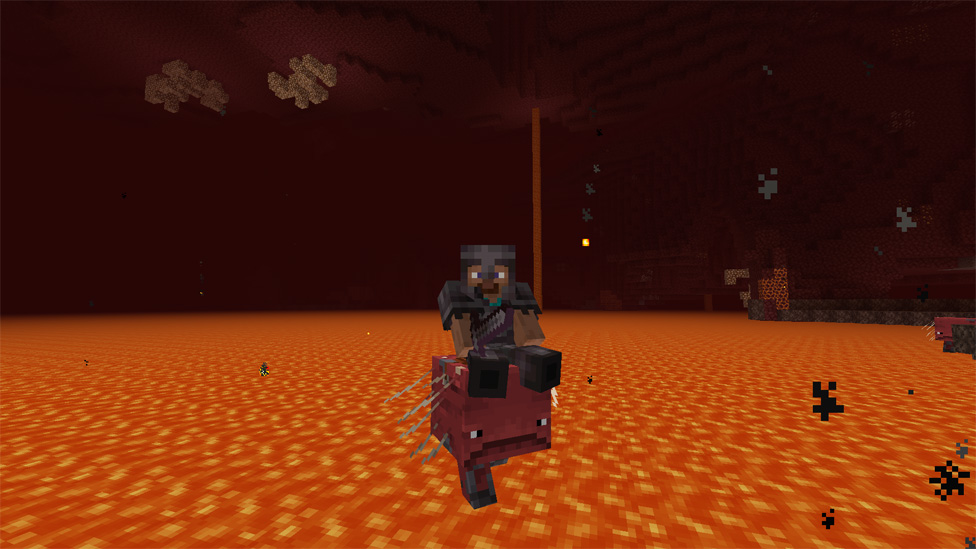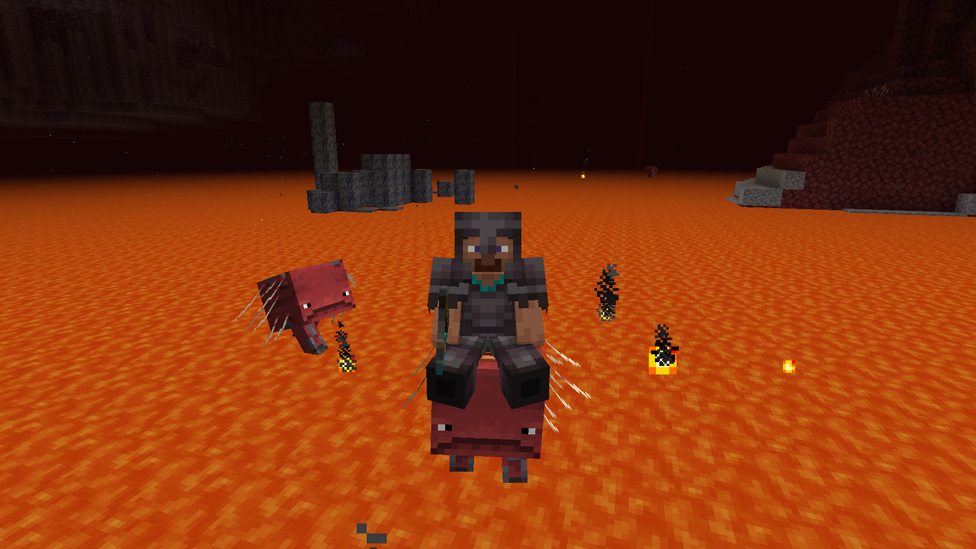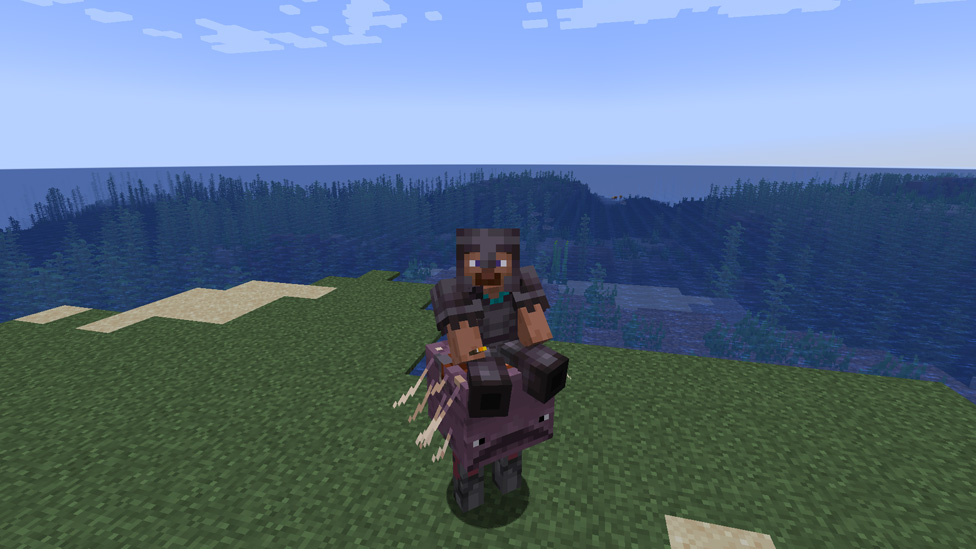How to Ride a Strider in The Nether
Make Your Own Minecraft Server For Free
Your own Minecraft server is only 5 minutes away! We support simple one click install for over 1000 unique modpacks.
Free Minecraft Server Hosting
How to Ride a Strider in The Nether

Minecraft is a sandbox world building game that has gained huge popularity because of its uniqueness in choices. Among the various sections of the game, Nether symbolizes an independent region in this diverse environment containing assortments of tastes and opportunities as well as difficulties. Another special tune introduced to the Nether was Strider, the most weird-looking creature a player could even ride through the volcanic seas.
In this complete guide, we are going to look at details of how to ride a strider in the Minecraft nether giving you a step by step guidance on how to go about it and also tips to make your journey successful.
Understanding the Strider
Before embarking on your Strider-riding adventure, it's important to know the creature itself. Striders are passive mobs found exclusively in the Nether and only spawn from two blocks up to height limit. Sharing a resemblance of an skeletal insect with long, spindly legs, these creatures roam the lava lakes dominating the Nether landscape. Despite their unsettling appearance, Striders are friendly and can be tamed for transportation purposes.To ride a Strider, you will need to stock up on a few crucial items in your subjugation, and among these is the saddle. Saddles are usually to be found at various points within the Minecraft ecosystem that is in dungeons, temples, or bastions. When you have one such of the saddles in your inventory, then you can go ahead to tame and later ride a Strider.
Taming a Strider
Taming a Strider involves a straightforward process. Follow these steps to ensure a successful bonding experience:Locate a Strider
Striders can be found wandering the shores of lava lakes in the Nether. Approach them cautiously, as they are generally neutral and won't attack unless provoked.Equip the Saddle
Place the saddle in your hotbar and select it. Approach the strider, then right click or press the button assigned for saddle use (default: right trigger on most platforms) to place the saddle onto the Strider.
Navigating the Nether with a Strider
Riding a Strider in the Nether opens up new possibilities for exploration and survival. Here are some key points to keep in mind as you navigate the fiery dimension:Lava Navigation
While riding one in the Nether, the major standout characteristic of the Strider is the simple fact that it can cross lava lakes without hurting from them. This makes it not only unlike any other mount in the game but adds to a distinct and substantial benefit to the players that put it to use when exploring the Nether.Navigating Hazardous Terrain:
The large lava lakes always become a concern to players in the Nether grinding for various goals and objectives. The walking on surface of the lava by the Strider removes the need for building new bridges or dodging through treacherous landscapes. This goes a long way in easing the ease of access to far off places especially, those that are surrounded by lava lakes.Accessing Valuable Resources:
In lava lakes, you'll typically find precious materials like Nether quartz and ancient debris. Striders can walk on lava. This allows gamers an easy way to these supplies and makes gathering them simpler. It saves time and lessens the chance of a fiery tumble into the lava.Strategic Nether Exploration:
When you're exploring the Nether, the Strider's ability to walk on lava is an advantage. If you want to find Nether fortresses, bastions, or other big landmarks, riding a Strider gives you flexibility to move in the dangerous terrain of the dimension.Strider Speed
How fast a Strider moves depends on how deep the lava is. It's key to know this to move well inside the Nether and arrive quickly where you want to.Speed Dynamics:
Striders go different speeds depending on lava depth. In barely deep lava, they move slow, but in very deep lava, they go faster. This speed change makes you think harder when riding Striders, letting you pick paths over deeper lava for a quicker trip.Choosing Optimal Routes:
So, every time you plan for your journey on a Strider, be keen about the depth of lava lakes that your paths are going through. Settle for deeper routes of the lava to maximize your speed potential of the Strider. Such considerations will save you so much time while you enjoy long-distance journeys in the Nether.Maximizing Travel Efficiency:
Test an avenue, and check how the Strider reacts to several depths of lava. Measure the difference in time and know when to make a trade-off that is based on the speed. This will place you on a decision-making point that is well informed and move so fast while traveling therefore giving you quick movement safely from one point to another.Water and Cold Biomes

Striders make great pals in the Nether's hot areas, but aren't so great in the Overworld, especially near water or cold zones. Knowing what Striders can and can't do helps keep them healthy and makes your Nether trips better.
Native to the Nether:
Striders call the Nether home, finding comfort in its lava-rich lands. Trying to move a Strider from the Nether to the Overworld through a portal can put them in harm's way. The drastic difference in the temperature of the scorching Nether and the colder Overworld can hurt the Striders a lot.Shivering and Perishing:
Once a Strider gets to the Overworld, it shivers immediately and slowly starts to get injured. Eventually, it may pass away from these injuries. The best way to avoid such sad situations is to let Striders stay in the Nether. Try not to bring them to other places.Specialized Nether Transport:
Striders are perfect for getting around the rough Nether. They're super useful in this tough place. They can't live in the Overworld, which shows they're really meant for the Nether. You should pick the right ride for each dimension's special traits.Dismounting
Getting off a Strider is simple, yet be careful. Bad monsters or tricky ground can make it dangerous. You need to know how to dismount properly. This makes moving from riding to walking easy.Simple Dismounting Process:
Press the left shift key, usually set as the default, to get off a Strider. Doing this switches you from riding the Strider to standing next to it. This straightforward process lets you leave your Strider quickly and smoothly when required. Cautious Dismounting in Hazardous Areas:
Getting off is easy, but watch out in some cases. If there are angry mobs or dangerous grounds where you're dismounting, make sure your landing area is safe. Doing this shields you from immediate danger and reduces harm risk when you disembark.Strategic Dismounting for Combat:
Thinking strategically for where to dismount your Strider when you know that it's time for forced combat. Be this placing the Strider in a way that it gives you, the player, tactical advantage or through its placement as a temporary obstacle between you and other hostiles. Mastering the art of strategic dismounting can be a valuable skill for surviving encounters in the Nether.Conclusion
Riding a Strider in the Nether provides not only an adventure but also a unique experience to spice up your Minecraft gameplay. From taming this skeletal insect to maneuvering around the flaming landscapes, here is all the details needed on riding a Strider. With that knowledge, the Nether will be faced with confidence, using these lava-walking creatures to escape your problems.Make Your Own Minecraft Server For Free
Your own Minecraft server is only 5 minutes away! We support simple one click install for over 1000 unique modpacks.
Start Your Server For Free!
Copyright 2019-2026 © ScalaCube - All Rights Reserved.